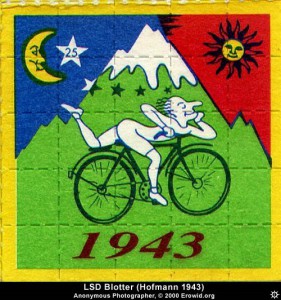In the 1940s and 50s, Drs. Humphrey Osmond and Abram Hoffer of the Weyburn Psychiatric Hospital in Saskatchewan, Canada administered LSD-25 to over 500 schizophrenics and alcoholics to study the effect of the drug on alcoholic thinking and behavior. While no hard recovery statistics are available to this blog writer, significant subjective growth was reported by the subjects in the tests.
They reported LSD allowed them to see their paranoid, grandiose and often abusive alcoholic behavior from a dramatic outside psychospiritual perspective. They reported seeing beyond their alcoholic egos into a world of spiritual right and wrong. They claimed to have come to understand how their drinking lifestyles were small and ignorant compared to the compassionate spiritual world opened to them via the drug.
In the Film Board of Canada documentary, “Hofmann’s Potion,” the Swiss chemist who first discovered the drug, Albert Hofmann, Osmond and Hoffer all interpreted their subject’s highly-subjective reports as an expansion of their consciousness from dishonest and self-centered to more compassionate and life-supporting. They became less shamed and more loving and self-responsible. They reported finding in themselves a new level of conscience that allowed them to abhor their old behavior and strive to be kind, honest and helpful to others.
Bill Wilson, Alcoholics Anonymous co-founder, became an LSD patient of Dr. Hoffer. One result of his treatment was the 1950s writing of the AA Grapevine article, “Taking Step Eleven”, urging alcoholics to deepen their prayer and meditation experience. In the article, Wilson dared not discuss his experience with LSD for fear of being accused of violating the group’s principles. He did, however, explain how he had come to believe that through prayer and meditation, alcoholics could discover new levels of spiritual strength within themselves. He also admits that prior to writing the article, he seldom practiced either prayer or meditation.
Did LSD inspire Wilson to a new level of spiritual sobriety? Nobody but Wilson himself knew, since the LSD experience is purely subjective. Unfortunately, simultaneous to Wilson’s hallucinogenic therapy with Hoffer, the United States government was secreting research projects into the use of LSD as a military mind control weapon. LSD became a controlled substance soon after that, as impure substitutes flooded the streets and the media filled with stories of LSD “freak-outs” and deaths. What Hofmann, Osmond and Hoffer hoped would become a serious medicine came under the control of the government, and to this day, LSD therapy for alcoholism does not exist.
Meanwhile, the Native American Church continues to use peyote ritually to help cure alcoholic drinking, and the African plant ibogaine is used throughout Europe to fight drug addiction. Hundreds of alcoholics and addicts annually seek out the South American plant compound ayahuasca, to help them rise above addiction. 1970s spiritual guru, Ram Dass (formerly Harvard professor Richard Alpert) today insists that providing safe sets and settings for the use of LSD through ritualized ceremonies can help prevent the bad experiences of persons who buy hallucinogens on the street and consume them without proper preparation and support.

Share this Post
